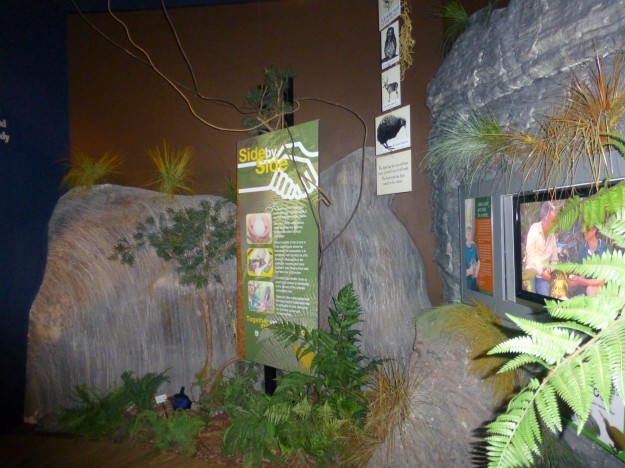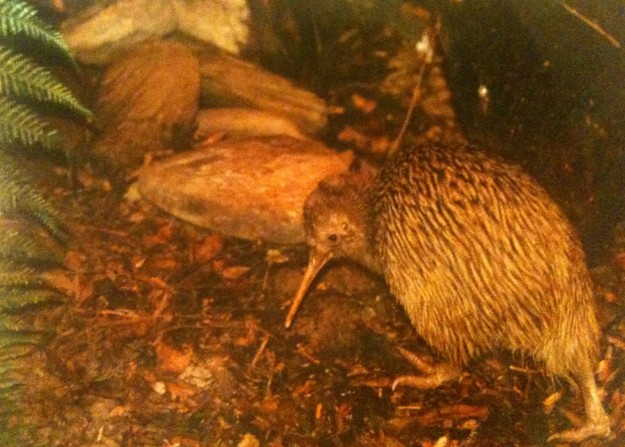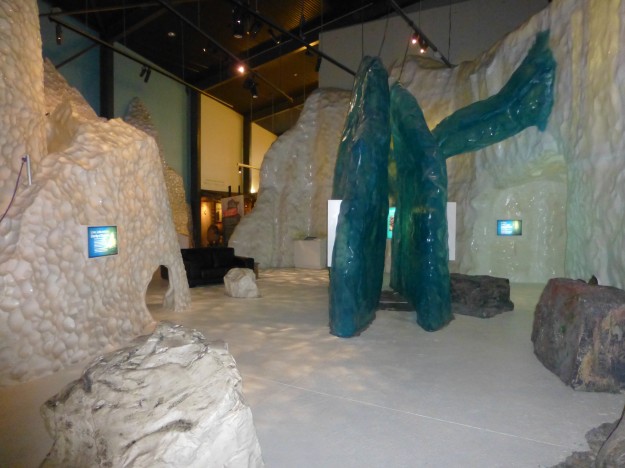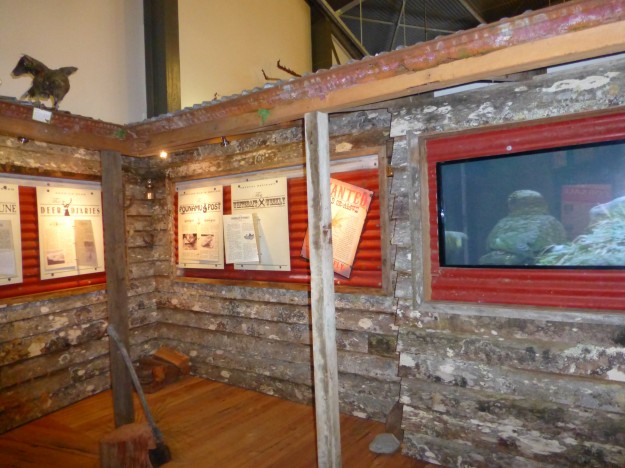One Day in New Zealand, This Happened…
Seeing and Hearing Baby Rowi Kiwi Birds in New Zealand

Two beady eyes stare at me in the near darkness. Then the creature cocks its head and turns its eyes downward as it plunges its long, pointy nose into the ground. A few more seconds pass, then it raises its skinny head and runs quickly, its round, plump belly wobbling back and forth as its two clawed feet propels it forward to attack.
“Squawwwk-blrrrrrr!” comes a noise from the creature’s prey, then two long beaks peck at each other and chase each other around in a blur of soft-looking fur and flashes of beak as they tumble over each other in a roly-poly fashion. Tom and I burst out laughing, quickly covering our mouths to stay quiet.
There’s no danger here. Just two 3-month old Kiwi birds play fighting with each other. We are at the West Coast Wildlife Centre in Franz Josef, New Zealand and for the past 10 minutes have been delightedly watching three little Rowi Kiwi birds chase each other around with surprising speed and peck their long beaks into whatever crevice of the ground interests them.

We aren’t actually outside. The West Coast Wildlife Centre is a preservation center for Rowi Kiwi birds and is working to bring the Rowi back from the brink of extinction. There are only 375 Rowi Kiwi birds left in the world, making it the rarest of all Kiwi birds, all of whom are in New Zealand.
As usual, humans are to blame for the near extinction of kiwi birds, though this time in an indirect way. The stoat, an animal that looks like a skinny mix between a fox and a weasel, was brought over to New Zealand in the late 1800s in order to control the rabbit population. Unfortunately, stoats decided they liked the easy-to-catch kiwi better. Possums are another predator to kiwi that are not native to the island. They were brought over as well and now torment pretty much everything, including the Rowi Kiwi bird. Rounding out the three largest predators to the Rowi Kiwi are dogs and cats. If humans don’t keep their dogs under control or people let their cats roam or just abandon them into the wild, the kiwi birds suffer.
However, now it’s humans helping keep the Rowi Kiwi numbers up. A group of dedicated researchers take eggs from the Rowi’s burrow. Don’t worry though – no “March of the Penguins” sadness here. The parents barely notice the egg being caught and go straight back into their usual day to day life when not breeding that consists of foraging for food. If luck is on the breed’s side, the female may even lay another egg before breeding season is over as she has two ovaries.
Why are the eggs taken instead of being left with their parent? Well, for starters, incubators are a much safer place for the eggs than its parent’s burrow, which is often an easy target for predators. On average, 80 eggs are laid every year and of those, only 50% hatch. Of the remaining 40, only 10% make it past 6 months, with most being killed by predators. Of that small 10% left, only 50% make it into adulthood, which comes out to just two new Rowi Kiwi being added to the dwindling population each year if left alone without help. By incubating the eggs and hatching them in the breeding center, 95% of the eggs make it. Additional precautions are taken from that point to ensure the hatchlings make it into adulthood.
That’s where the small enclosure Tom and I are giggling in at the West Coast Wildlife Centre comes into play.
The hatchlings live here in this simulated, open environment until they’re a year old and then they’re moved to a predator free zone in the wild until they’re big enough to be moved back to their natural habitat.
Kiwis are cuddly, funny looking things. The many cameras pointing at us are the only thing keeping me from reaching down and petting one. And I really, really want to pick one up and cuddle it. There are pictures hung up in the Wildlife Centre of people holding a full-grown kiwi and the bird nestles right into the human’s arms. I can only imagine how sweet and cuddly these little kiwi bird toddlers would be to hold. Although, they’re so active right now they may not be so easy to hold.
Tom and I arrived to the West Coast WildLife Centre right when the doors opened at 8:30 in the morning, but we had to wait to go into the enclosure until they switched the lights for the Rowi Kiwi from daytime to nighttime which doesn’t happen until 9am. So when Tom and I arrived, the little kiwi birds had just woken up and were ready to forage for food. The enclosure is long and dark with red-hued lights shining on parts of the enclosure. It took a few minutes for our eyes to adjust but then we were able to see the Kiwi birds quite well. There is no glass so we’re able to lean over the fence and stare straight down at the Kiwi birds that are running amok right before us.
One is currently dashing like a maniac back and forth against the fence.
“Does he smell us?” Tom asks in a whisper. Kiwis are sensitive to loud noises so we’ve been instructed to be quiet in the enclosure.
“I don’t know. I think he might be moving some of the twigs and stuff down there,” I whisper back. The little kiwi bird is furiously running back and forth like the Tasmanian Devil, his little legs surprisingly fast and his hunched forward shoulders making it seem like he should have four legs. That, along with the downy fur covering his back instead of feathers, gives him the appearance from above of a really well-fed rodent – a cute one, though, like from a Disney film.
“I want a kiwi bird!” I exclaim quietly to Tom. “They are so cute!”
I am quite certain I’ll never get a Kiwi out of New Zealand, which is why it’s so nice the West Coast Wildlife Centre gives visitors the chance to see these wonderful creatures in a very educational setting. All species of kiwi birds are endangered plus are very shy so it’s quite rare to see one in the wild.
When Tom and I are finally able to drag ourselves away from the adorable Rowi Kiwis, we walk through the other exhibits at the West Coast Wildlife Centre. The town of Franz Josef is at the base of the massive Franz Josef Glacier and the center has an exhibit on glaciers where we learn more about glaciers amid a mock glacier (great for kids to play on and through) and learn how glaciers affect the climate.

The next exhibit is set up a bit like a hut and has learning stations that look like books talking about what brought people out to the west coast of the South Island in New Zealand (gold) and how problematic deer became after being introduced to the island (apparently animals should never be introduced to New Zealand – it always goes wrong so it seems).

The Wildlife Centre offers two separate tours: the All-Inclusive Day Pass (NZ$30), which is what Tom and I did and gives you access to the museum and Kiwi enclosure. There is also the Kiwi Backstage Pass (NZ$50), which includes everything the first pass does, but also lets you get a tour of the breeding room during specific times throughout the day. A portion of all proceeds from the tickets, gift shop, and onsite café go to the breeding program.
I hope I see a kiwi bird again someday and that soon there’ll be thousands instead of hundreds of Rowi Kiwi birds running around New Zealand. Did I mention how ridiculously adorable they are?
Very neat! I wish I could have seen full-grown ones, too.
We saw them in Rotorua. Pretty darn cute these birds. We didn’t get to see the babies run around though. They were all little furry sleeping balls in their incubators that you could only barely see in the dark. Was great to have seen them though.
The breed they had there was way bigger than I expected. We saw a few full grown ones in the enclosure and way bigger than the chicken size than I had expected.
All this interesting wildlife/nature is one of the main reasons I want to visit this part of the world one day.